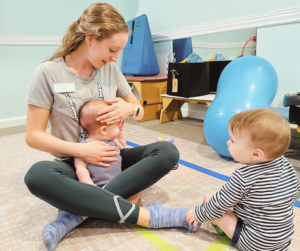Physical Therapy for Torticollis

Did you know pediatric physical therapy can help treat babies with Torticollis? Congenital Muscular Torticollis (CMT) affects around 3% of babies.
What is Torticollis?
Torticollis occurs when one of the muscles in the neck, called the sternocleidomastoid becomes tight. When this happens, it causes the baby to look mainly to one side. They also have a slight tilt of their head toward the opposite side. Although not all rotation preferences indicate torticollis, it is good to encourage your baby to spend time looking at both sides. Doing this will encourage symmetrical strength and range of motion of their neck and spinal muscles. Torticollis can affect the baby’s whole body. Head/neck positioning can also contribute to feeding difficulties, trunk and shoulder tightness, and difficulty attaining infant motor skills, if not addressed.

Ms. Karli gives us tips to use at home!
What is Plagiocephaly?
Deformational Plagiocephaly, or Flat Head Syndrome, occurs in infants as a result of disproportional forces being placed on one area of their skull while they are developing in-utero. It can also occur postnatally if they spend too much time in one position. This may occur because the infant’s skull bones are softer and still developing. If the baby spends the majority of their time lying on their back or side, a flat spot can develop on that part of the skull, due to the malleable nature of their skulls.
Often these conditions co-occur, as the torticollis that contributes to a rotation preference causes excess pressure to be placed on only one side of the skull, resulting in a flat spot.

Ms. Karli, a pediatric physical therapist, treats children as young as a few weeks old!
Physical Therapy For Torticollis & Plagiocephaly
Did you know that pediatric physical therapy can help correct this? In fact, the Pediatric Section of the American Physical Therapy Association recommends parent education as the primary prevention strategy. Then they recommend a combination of physical therapy and/or helmet orthosis (depending on the child’s presentation) as the primary treatment options. A helmet is only needed if your baby’s head shape is not responding to physical therapy and re-positioning strategies AND their head measurements indicate that it is needed.
How can you help prevent a flat spot on your baby’s head?
What are some strategies to prevent the development of a flat spot? We recommend starting these in early infancy!
- Alternate positions that your baby spends time in while they are awake, and avoid excessive container time. Examples: excessive time spent in car seats, swings, seats, etc.).
-
Change positions when feeding, carrying, and holding your baby.
-
Provide supervised tummy time while awake to help your baby develop head control. This gives an opportunity for no external pressure to be applied to their skull.
Want More Information about Physical Therapy and Plagiocephaly?
Visit https://pediatricapta.org/
